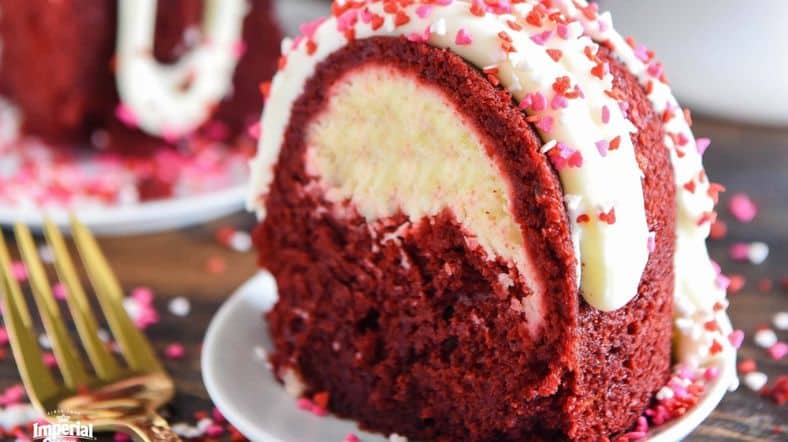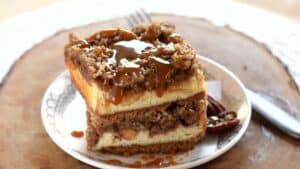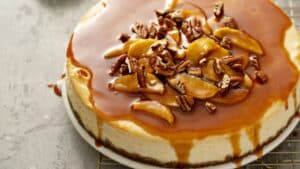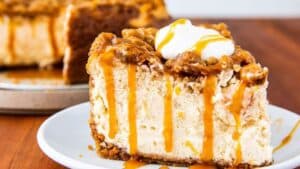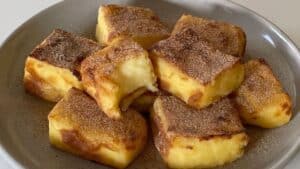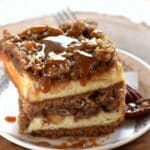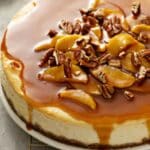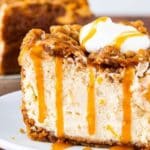Indulge in a rich, moist Red Velvet Cheesecake Bundt Cake with creamy layers, perfect for holidays or special occasion.
There’s something inherently indulgent about red velvet. Add cheesecake to the mix, layer it inside a Bundt mold, and you’re stepping straight into dessert wizardry. This ain’t your grandma’s pound cake. This is the sort of bake that stops conversation mid-sentence. You know, that moment when the fork goes down and eyes close for just a second too long? That’s what we’re after here.
This article is a deep dive into the construction, science, and magic of a Red Velvet Cheesecake Bundt Cake. Not a box-mix, throw-it-in-the-oven job. We’re talking scratch baking with precision, rich texture, and visual drama. This is for pros who want to push the flavor profile and the visual impact without compromising structure or shelf life.
We’ll cover technique, ingredient behavior, flavor balance, moisture control, and even plating. Yeah, plating. Because you don’t build a cake like this just to slap it on a paper plate and call it a day.
Why This Cake Matters in the Modern Pastry Landscape
Bundt cakes, long the workhorse of home kitchens, are staging a quiet resurgence in high-end pastry kitchens. Not flashy like entremets. Not as fiddly as layered gateaux. But incredibly versatile.
The red velvet Bundt cake, when done right, offers a sponge that’s both tender and structured. It’s got cocoa’s earthiness, that telltale acidity, and a vibrant, slightly rebellious hue. But alone, it’s not enough.
Enter cheesecake: creamy, tangy, custard-smooth. The layering of cheesecake inside the Bundt brings contrast—in flavor, in temperature if served semi-chilled, and in texture. It’s not just a cake. It’s a narrative. And every slice tells a story.
In professional settings, this cake has become a sleeper hit for upscale cafés and patisseries looking to bridge traditional comfort with modern wow-factor. A 2023 report by Bakery Global Insights noted a 17% uptick in Bundt-style cakes appearing on boutique menus across Europe and North America, especially those with unexpected fillings.
Ingredient Selection: Every Gram Counts
Red velvet’s core identity hinges on two key elements: cocoa and acid. The balance is delicate. Go too heavy on the cocoa, and you get devil’s food. Not enough, and it’s just red-colored sponge.
For professionals, use a Dutch-process cocoa for richness and color consistency. Natural cocoa leans too far acidic and muddies the red hue. And the vinegar? Stick with white vinegar. It’s clean and plays nicely with buttermilk, which should be full-fat and cultured.
Flour? All-purpose works, but cake flour gives you that tight, tender crumb. If you’re scaling, consider a 70/30 mix of cake to AP flour for balance.
Now, the cheesecake. Don’t cheap out. Use a high-fat cream cheese—minimum 33% milkfat. Philadelphia is the gold standard, but there are boutique producers whose product is silkier, less tangy. Great for layering. A single egg yolk in the cheesecake base adds just enough body without curdling during the bake.
Oh, and sugar? Use superfine. It dissolves evenly in both batters. Coarse sugar leaves speckles in the cheesecake. That’s a no.
Tools and Mold Considerations
The Bundt pan isn’t just a vessel—it’s a co-star. Avoid cheap aluminum. It warps, overbakes the edges, and ruins the layering. Go for heavy-gauge non-stick steel or cast aluminum. Nordic Ware remains the industry benchmark for good reason.
You’ll also need:
- A paddle attachment (stand mixer a must here)
- An offset spatula (for layering precision)
- A cake thermometer (internal temp of cheesecake should hit ~165°F at the core)
Lightly grease every nook of the Bundt pan. Don’t rely solely on non-stick spray. Use a hybrid: brush with melted butter, dust with cocoa powder. Flour leaves pale streaks. Cocoa blends in.
The Layering Process: Build, Don’t Just Pour
Here’s where most bakers get cocky—and then things collapse.
You start by piping in a thick base layer of red velvet batter. It should come up about a third of the pan. Not half. Not eyeballed. Weigh it out. In a 12-cup Bundt pan, that’s about 450g.
Next, pipe the cheesecake mixture carefully. Do not pour. Pouring breaks the bottom layer and causes vertical bleed during the bake. Pipe in a ring, staying about 1cm away from the edge of the pan. Then smooth with an offset spatula.
Finally, layer the remaining red velvet batter on top. Again—pipe, don’t dump. This step locks the cheesecake in. If done right, the filling won’t hit the edges, giving you a hidden core. Very 2020s pastry chic.
Baking: Precision Over Guesswork

Preheat to 325°F. Not 350°F. That 25-degree difference reduces surface hardening and lets the cheesecake set gently.
Bake for 55 to 65 minutes, rotating once. You’re looking for a domed top, slight pulling from the sides, and an internal core temp of around 200°F. A toothpick won’t help you here—the cheesecake confuses the read. Use a probe thermometer, and go in from the top post-bake.
Rest in the pan for at least 30 minutes before inverting. If you rush it, the cheesecake compresses and the cake tears. Once flipped, chill for two hours. Yes, hours. The chill locks the structure. Don’t skip it. Ever.
The Finishing Touch: Glazes, Not Frosting
Skip the cream cheese frosting—too heavy, too cloying. Go for a buttermilk glaze or a white chocolate drizzle.
A simple buttermilk glaze:
- 1 cup powdered sugar
- 2 tbsp buttermilk
- ½ tsp vanilla
- Pinch of salt
Whisk till smooth, pour over chilled cake, and let it set. You want drips, not a coat. This ain’t a birthday cake.
White chocolate ganache (3:1 ratio) works beautifully too, especially with a pink tint or beet powder dusting. Adds sheen and contrast. Bonus: holds well in refrigerated display cases.
Storage and Shelf Life
Here’s the underrated part. This cake holds.
Wrapped tightly in plastic wrap, it stores beautifully in the fridge for up to 5 days. In fact, the flavor deepens by day two. The cheesecake layer firms up, the cocoa rounds out, and the crumb tightens. For bakery use, it slices clean, plates elegantly, and can be pre-portioned.
For freezing: yes, it’s freezer-friendly. Slice, wrap in parchment, then plastic, then foil. Thaw in fridge overnight. Don’t microwave. That’ll wreck the crumb.
Troubleshooting Common Issues
Sunken top? Overmixed batter. Introduced too much air. Next time, mix just till incorporated.
Cheesecake layer bleeding out? You poured it, didn’t you? Pipe it next time. And weigh your layers.
Cracked exterior? Oven too hot or mold undergreased. Stick to 325°F and prep your pan like your job depends on it.
Red color turned brown? Too much cocoa or used natural instead of Dutch-process. And yes, food coloring matters—use gel, not liquid.
Emerging Trends: Why It’s More Than a Fad
Pastry chefs are leaning back into nostalgia bakes. But with twists. The red velvet cheesecake Bundt is a perfect canvas for modern reinterpretation.
Some are incorporating flavor variations:
- A swirl of raspberry compote in the cheesecake layer.
- Infusing the red velvet with espresso or hibiscus.
- Swapping vanilla in the glaze for bourbon or orange blossom water.
Others are turning this into plated desserts—slicing the cake into thick wedges, torching the edges, and serving with quenelles of mascarpone gelato and cocoa nib dust.
Instagram loves it. Customers love it. And it fills that dessert menu slot between rustic and refined.
Final Thoughts: Craft and Craveability
At the professional level, baking isn’t just about taste. It’s architecture. It’s chemistry. And yeah, it’s aesthetics too.
This Red Velvet Cheesecake Bundt Cake hits all the notes—visual drama, layered flavor, texture contrast, and craveable nostalgia. It’s the kind of dessert that doesn’t just sell by the slice. It sells itself in photos, on forks, and in memories.
So if you’re running a patisserie, an upscale café, or even just testing menu options—this is a dessert worth mastering. Not hacking. Mastering.
Because when someone says, “This is the best cake I’ve ever had,” you wanna believe them. And you want them to come back. Again and again.
And that’s what this cake does. Every. Single. Time.
